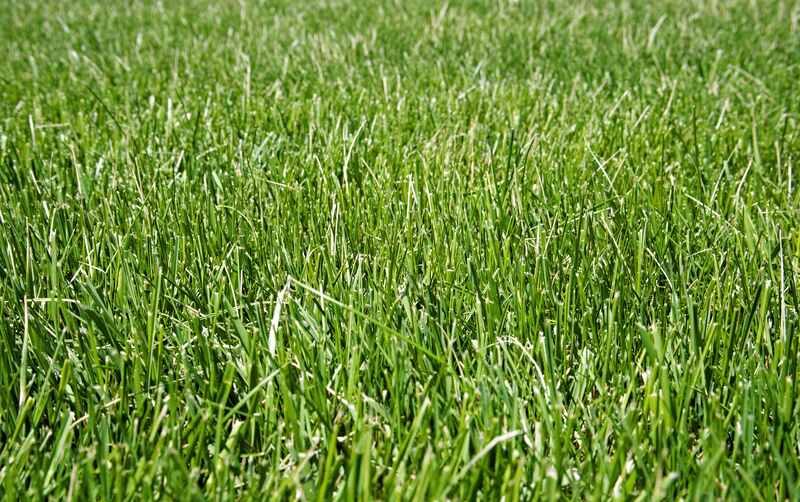
The best time to fertilize fine and tall fescues is from September to early November (fall), their active growth season. This prepares them for the harsh winter conditions, enhances their shoot density, and helps them recover from summer dormancy.
A second application in spring can be performed, but only if necessary. Applying more than 2 pounds of nitrogen per 1,000 square feet per year can decrease turfgrass quality and encourage weed growth. For this reason, a second fertilization must be performed at lower rates than fall fertilization.
We’ll expand on the proper timing of fertilization, along with the type and amount of fertilizer your fescue lawn needs. But if you’re looking to establish a fine fescue turf or caring for tall fescue, here are guides for each one:
When and How to Fertilize Fescues
Feeding fine and tall fescues is all about finding the right time and method of application. Fine and tall fescues need to be fed before winter to survive the tough conditions. But if a second application is needed in spring, the two fescue species do not share the same timing.
Soil test results will pinpoint the exact amount of nitrogen you’ll need to apply and when. The following fertilization schedule is a general guideline for fescue lawns. For best results, perform a soil test and follow its fertilizer recommendations.
Pro Tip: Optimal fertilization timing varies depending on your local climate and regulations. Consult a pro or check with your local extension office to determine the best window for fertilization in your area.
Fertilizing Fescue in Fall (September – November)

For the first application, early September is the best time to fertilize both fine and tall fescues.Apply 0.5 to 1 pound of nitrogen per 1,000 square feet.
An optional second application of 0.5 to 1 pound of nitrogen per 1,000 square feet can be made to prepare your fescue turf for the winter. However, the timing varies depending on where you live.
Whether you’re growing tall or fine fescue, a second application should be made in early October if you live up north. If you live down south, make the second application in early November.
As a general rule, it’s best to use slow-release fertilizer when applying more than 0.5 pounds of nitrogen per 1,000 square feet at once.
Fertilizing Fescue in Spring (March – May)
If you applied less than 2 pounds of nitrogen in the fall, spring fertilization may be possible if your fescue turf lost some of its green during winter.
A spring application for fine fescue is best in May (late spring), June at the latest. It’s best to keep the amount of nitrogen fertilizer between 0.5 and 1 pound per 1,000 square feet.
Tall fescues can receive their spring application in April or early May. Apply between 0.2 and 0.5 pounds of nitrogen per 1,000 square feet.
Can You Fertilize Fescue in Summer (June – August)?
Fertilizing fescues is fruitless during summer, since fescues typically go dormant during this period.
However, your fescue may benefit from nitrogen intake if you need to repair it from severe damage. Apply between 0.2 and 0.5 pounds of N per 1,000 square feet to green up your fescue turf and help it recover from summer damage (but only if absolutely necessary).
How to Apply Fertilizer Properly

Learning how to fertilize your lawn properly ensures your grass gets all the needed nutrients, and that you don’t waste your hard-earned money.
- Step 1: Water your lawn two days before fertilizing.
- Step 2: Conduct a soil test to determine your fescue turf’s nutrient needs.
- Step 3: Based on the soil test’s results, choose the appropriate fertilizer with the right NPK ratio.
- Step 4: Carefully read and follow the manufacturer’s instructions on the fertilizer label.
- Step 5: Apply the fertilizer using a broadcast spreader or drop spreader. They both deliver more efficient results than fertilizing by hand, but still acceptable to help you save money on fertilizing equipment.
- Step 7: Lime your lawn if your soil needs it (check the test result)
- Step 6: Irrigate the lawn to ensure nutrients penetrate the soil effectively. Additionally, chemicals that remain on the blades may cause them to burn. Learn more about what fertilizer burn is.
FAQ About Fertilizing Fescues
Can you lime your lawn after applying fertilizer?
Yes, you can lime your lawn after applying fertilizer. Whether or not your lawn needs it depends on the soil test’s result. If the test reveals that your soil is acidic, lime can be applied to reduce the acidity level. Browse through this detailed article on when and how to lime a lawn.
Are there states that ban the use of phosphorus fertilizers?
At least 11 states generally ban the use or sale of phosphorus fertilizers, including Illinois, Michigan, New York, and Virginia.
However, there are exceptions in which phosphorus fertilizers are allowed:
- Curing a lack of phosphorus
- Establishing a new turf
- Repairing your turf
It’s best to check with your local state government or town hall regarding the laws on the use or prohibition of phosphorus fertilizers. Here’s a deeper dive at cities limiting the use of lawn fertilizers and pesticides.
How many types of fertilizer spreaders are there?
You can use a broadcast spreader that distributes fertilizer in a fan-like pattern, spreading in all directions and covering a wide area. Another option is the drop spreader. Explore some of the best fertilizer spreaders.
Hire a Pro to Upkeep Your Fescue Turf
Fescues need fertilizer rich in nitrogen to remain healthy and green throughout the seasons. However, applying fertilizer is just part of your lawn’s maintenance requirements. One unavoidable task is cutting the grass to keep it at an ideal height, keeping weeds from taking over.
Hire a local lawn care professional to mow your grass, fertilize, and trim the shrubs for the best-looking lawn in the neighborhood.
Main Image Credit: dean / Adobe Stock / License





